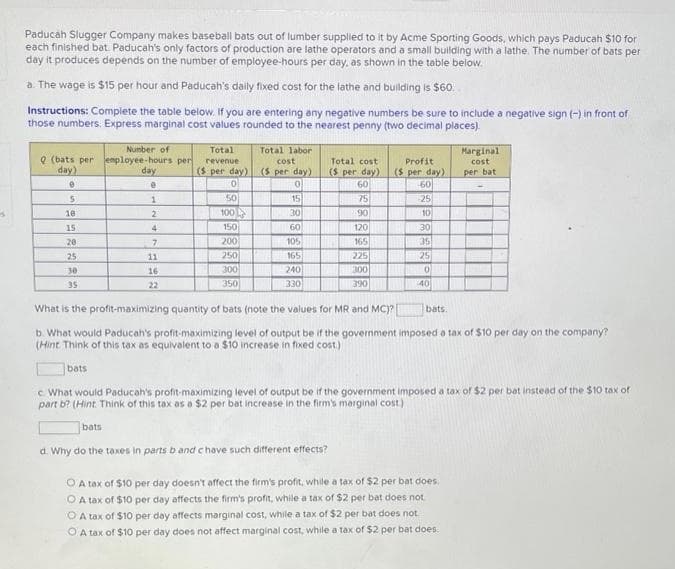b. Whet would Paducah's profit-maximizing level of output be if the government imposed a tax of $10 per day on the company? (Hint Think of this tax as equivalent to a $10 increase in fixed cost) bats c What would Paducah's profit maximizing level of output be if the government imposed a tax of $2 per bat instead of the $10 tax of part b? (Hint Think of this tax as a $2 per bat increase in the firm's marginal cost) bats d. Why do the taxes in parts b and chave such different effects? O A tax of $10 per day doesn't affect the firm's profit, while a tax of $2 per bat does. OA tax of $10 per day affects the firm's profit, while a tax of $2 per bat does not O A tax of $10 per day affects marginal cost, while a tax of $2 per bat does not O A tax of $10 per day does not affect marginal cost, while a tax of $2 per bat does
b. Whet would Paducah's profit-maximizing level of output be if the government imposed a tax of $10 per day on the company? (Hint Think of this tax as equivalent to a $10 increase in fixed cost) bats c What would Paducah's profit maximizing level of output be if the government imposed a tax of $2 per bat instead of the $10 tax of part b? (Hint Think of this tax as a $2 per bat increase in the firm's marginal cost) bats d. Why do the taxes in parts b and chave such different effects? O A tax of $10 per day doesn't affect the firm's profit, while a tax of $2 per bat does. OA tax of $10 per day affects the firm's profit, while a tax of $2 per bat does not O A tax of $10 per day affects marginal cost, while a tax of $2 per bat does not O A tax of $10 per day does not affect marginal cost, while a tax of $2 per bat does
Chapter16: Labor Markets
Section: Chapter Questions
Problem 16.6P
Related questions
Question

Transcribed Image Text:Paducah Slugger Company makes baseball bats out of lumber supplied to it by Acme Sporting Goods, which pays Paducah $10 for
each finished bat. Paducah's only factors of production are lathe operators and a small building with a lathe. The number of bats per
day it produces depends on the number of employee-hours per day, as shown in the table below.
a. The wage is $15 per hour and Paducah's daily fixed cost for the lathe and bulding is $60
Instructions: Complete the table below. If you are entering any negative numbers be sure to include a negative sign (-) in front of
those numbers. Express marginal cost values rounded to the nearest penny (two decimal places).
Number of
Total
Total labor
Marginal
Q (bats per employee-hours per
day)
revenue
cost
Total cost
Profit
cost
day
(8 per day) (S per day)
(S per day)
60
($ per day)
60
-25
per bat
in
50
15
75
1e
30
90
10
150
200
250
300
350
30
35
25
15
4
60
120
20
105
165
25
1
165
225
30
16
240
300
35
22
390
40
OEE
What is the profit-maximizing quantity of bats (note the values for MR and MC)?
bats.
b. Whet would Paducah's profit-maximizing level of output be if the government imposed a tax of $10 per day on the company?
(Hint Think of this tax as equivalent to a $10 increase in fixed cost)
bats
c What would Paducah's profit-maximizing level of output be if the government imposed a tax of $2 per bat instead of the $10 tax of
part b? (Hint. Think of this tax as a $2 per bat increase in the firm's marginal cost)
bats
d. Why do the taxes in parts b and chave such different effects?
O A tax of $10 per day doesn't affect the firm's profit, while a tax of $2 per bat does,
O A tax of $10 per day affects the firm's profit, while a tax of $2 per bat does not
OA tax of $10 per day affects marginal cost, while a tax of $2 per bat does not
O A tax of $10 per day does not affect marginal cost, while a tax of $2 per bat does.
Expert Solution
This question has been solved!
Explore an expertly crafted, step-by-step solution for a thorough understanding of key concepts.
This is a popular solution!
Trending now
This is a popular solution!
Step by step
Solved in 2 steps

Knowledge Booster
Learn more about
Need a deep-dive on the concept behind this application? Look no further. Learn more about this topic, economics and related others by exploring similar questions and additional content below.Recommended textbooks for you



Exploring Economics
Economics
ISBN:
9781544336329
Author:
Robert L. Sexton
Publisher:
SAGE Publications, Inc



Exploring Economics
Economics
ISBN:
9781544336329
Author:
Robert L. Sexton
Publisher:
SAGE Publications, Inc

Principles of Microeconomics (MindTap Course List)
Economics
ISBN:
9781305971493
Author:
N. Gregory Mankiw
Publisher:
Cengage Learning

Principles of Economics (MindTap Course List)
Economics
ISBN:
9781305585126
Author:
N. Gregory Mankiw
Publisher:
Cengage Learning

Principles of Economics, 7th Edition (MindTap Cou…
Economics
ISBN:
9781285165875
Author:
N. Gregory Mankiw
Publisher:
Cengage Learning